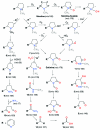Thirdhand tobacco smoke: emerging evidence and arguments for a multidisciplinary research agenda
- PMID: 21628107
- PMCID: PMC3230406
- DOI: 10.1289/ehp.1103500
Thirdhand tobacco smoke: emerging evidence and arguments for a multidisciplinary research agenda
Abstract
Background: There is broad consensus regarding the health impact of tobacco use and secondhand smoke exposure, yet considerable ambiguity exists about the nature and consequences of thirdhand smoke (THS).
Objectives: We introduce definitions of THS and THS exposure and review recent findings about constituents, indoor sorption-desorption dynamics, and transformations of THS; distribution and persistence of THS in residential settings; implications for pathways of exposure; potential clinical significance and health effects; and behavioral and policy issues that affect and are affected by THS.
Discussion: Physical and chemical transformations of tobacco smoke pollutants take place over time scales ranging from seconds to months and include the creation of secondary pollutants that in some cases are more toxic (e.g., tobacco-specific nitrosamines). THS persists in real-world residential settings in the air, dust, and surfaces and is associated with elevated levels of nicotine on hands and cotinine in urine of nonsmokers residing in homes previously occupied by smokers. Much still needs to be learned about the chemistry, exposure, toxicology, health risks, and policy implications of THS.
Conclusion: The existing evidence on THS provides strong support for pursuing a programmatic research agenda to close gaps in our current understanding of the chemistry, exposure, toxicology, and health effects of THS, as well as its behavioral, economic, and sociocultural considerations and consequences. Such a research agenda is necessary to illuminate the role of THS in existing and future tobacco control efforts to decrease smoking initiation and smoking levels, to increase cessation attempts and sustained cessation, and to reduce the cumulative effects of tobacco use on morbidity and mortality.
Conflict of interest statement
FAMRI had no role in the design, conduct, interpretation or publication of the research, and the organization does not gain or lose financially through publication of any article. The other authors declare they have no actual or potential competing financial interests.
Figures



Comment in
-
Thirdhand smoke in review: research needs and recommendations.Environ Health Perspect. 2011 Sep;119(9):a399. doi: 10.1289/ehp.119-a399b. Environ Health Perspect. 2011. PMID: 21885371 Free PMC article. No abstract available.
References
-
- Boeniger MF. Use of ozone generating devices to improve indoor air quality. Am Ind Hyg Assoc J. 1995;56:590–598. - PubMed
-
- Borgerding MF, Bodnar JA, Wingate DE. The 1999 Massachusetts Benchmark Study. Final Report. Massachusetts, Department of Health. 2000. Available: http://legacy.library.ucsf.edu/tid/yek21c00 [accessed 4 March 2011]
-
- Catassi A, Servent D, Paleari L, Cesario A, Russo P. Multiple roles of nicotine on cell proliferation and inhibition of apoptosis: implications on lung carcinogenesis. Mutat Res. 2008;659:221–231. - PubMed
Publication types
MeSH terms
Substances
LinkOut - more resources
Full Text Sources
Other Literature Sources
Medical

